'London and Beyond' - Part 1, Ceramic Art London.
- thora50
- Jun 25
- 9 min read

I have thoroughly enjoyed my time in London, visiting Ceramic Art London and the V&A Museum. Everything was above expectations, including the prices!
At CAL, I was initially looking at ceramics which caught my eye. There were a lot, some makers I was familiar with some I wasn't. The show was very well laid out, and the stalls reflected this careful planning. The variety was immense so there was something for everyone. Some high prices were commanded by the more experienced potters ( into the 000's), but also a nice smaller piece could be bought for around £80.
Secondly, my aim was to chat to some Makers. There were a few, whose work really interested me and who were friendly and open to chat. I felt more empowered to do this now since studying for my Masters, with more knowledge of the importance of context and having a broader experience of ceramic processes.
I was able to see if there were any overlaps with my project, and as my project is under the vast umbrella of climate change and biodiversity loss, I could see quite a lot of parallels in other people's work.
Thirdly I was looking at sgraffito. There wasn't so much of this, but it was interesting to see that carving as opposed to sgraffito is becoming popular as a method. I have researched lino cut printing and (Japanese) wood block printing, both of which involve carving. Some of my older sgraffito work and more recently with lino cut tools falls into this category. I probably saw more carving than sgraffito. I am enjoying using Aliyah's linocut tools for my work, using a thick clay base and a thick slip layer. Sgraffito or carving can be vastly different depending on the above, thickness of the slip. I quite often put two layers of different coloured slip on my platters. This can cause a quirky effect with some happenstance if you are lucky!



These are the exhibitors that I found most interesting;
Claudette Forbes

I was drawn to these ceramic cows with gold parts. It reminded me of an artist I saw and liked back in 2023 at the British Ceramics Bienniel. I mentioned this to Claudette, but she wasn't aware of this artist, but was interested.
Her work highlights issues surrounding drinking milk and eating beef and the killing and exploitation of cows in order to do this. Since starting my project, I try and eat vegetarian.
She had done some prints which were about this issue too, and her exhibition 'Poor Cow' has won awards.
Bahareh Khomeiry
She is an Iranian artist, who makes vessels from plats of clay. This is in response to the protests by women in Iran a couple of years ago about not covering their face and wearing their long hair free, standing up for women's rights.
The clay is the colour of the women's hair.
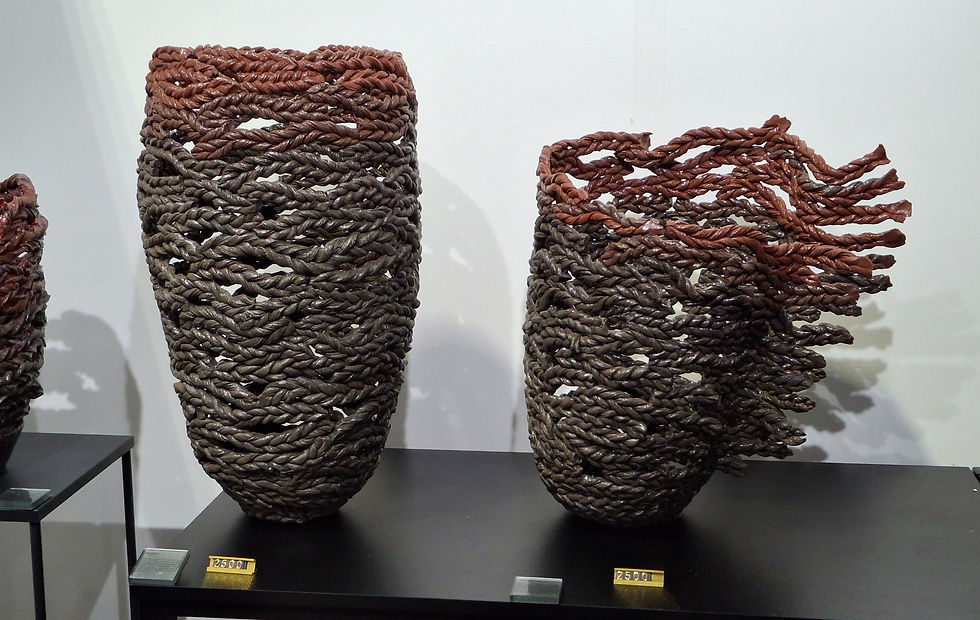
The plats represent the braided hair of the women, which had been cut off. Some baskets were broken out of, to symbolise the women trying to break free from their constraints.
Agalis Manesi

She is a painter, who paints on a tin glaze, (maieolica ware). I strive to be a painter too, and I have also painted on tin glazed ceramics pre MA, mainly of Chinese ladies and cats.
She uses diluted oxides or coloured oxides mixed with underglazes. I also discovered that diluted underglazes paint well on tin glaze, though in my work, I have a strong black line surrounding the image.
She has a book ' A Journey Painted in Clay'.
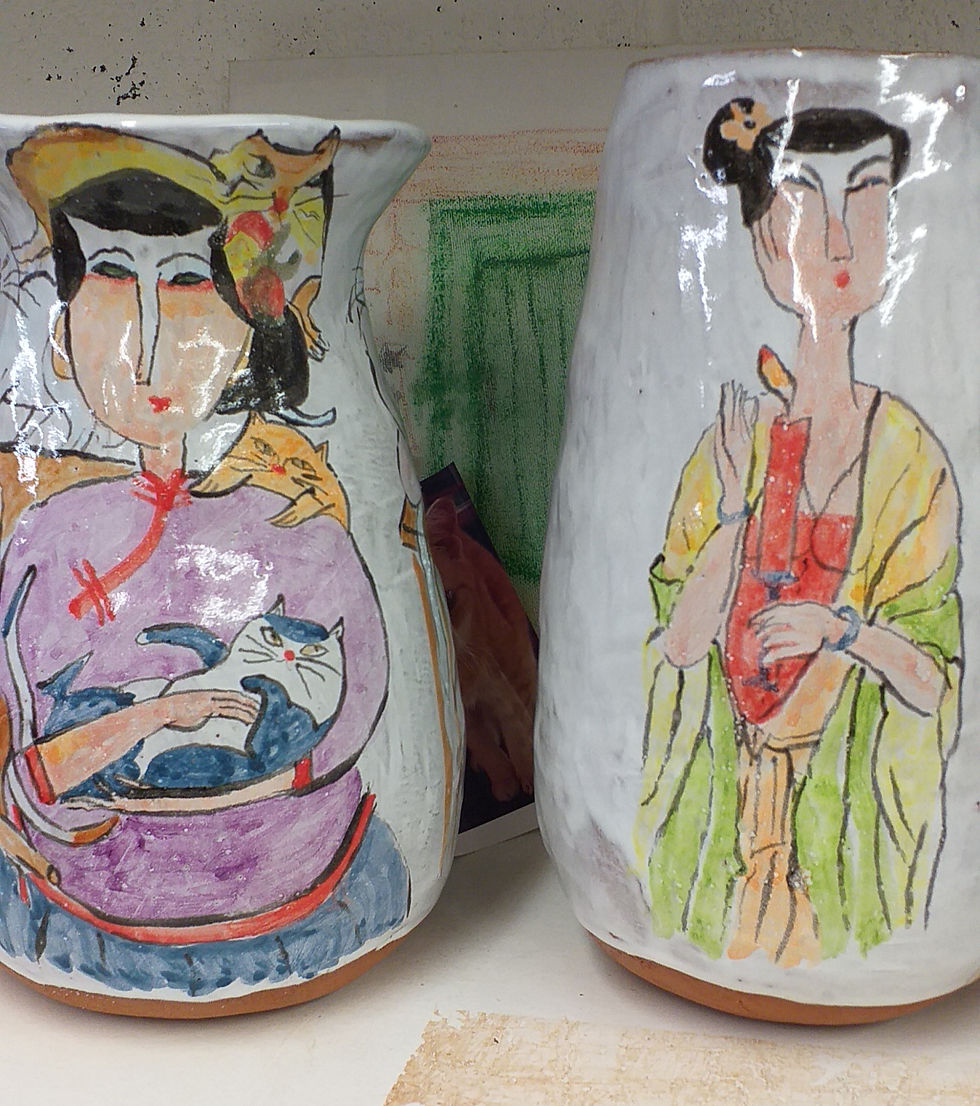
Enrique Perezalba
I like large scale ceramics, and these bottles of Enrique's were exceptionally large ( weighing 10kg +), but they were scaled up replicas of the miniature single use plastic bottles which are so common and are now causing so much harm to wildlife and the planet.
'He tries to turn something worthless into something exquisite' ( CAL catalogue 2025). They were massive and they were exquisitely glazed. They were exhibited on replicas of the crates used to ship this sort of item. I would have liked one of these bottles in my house!
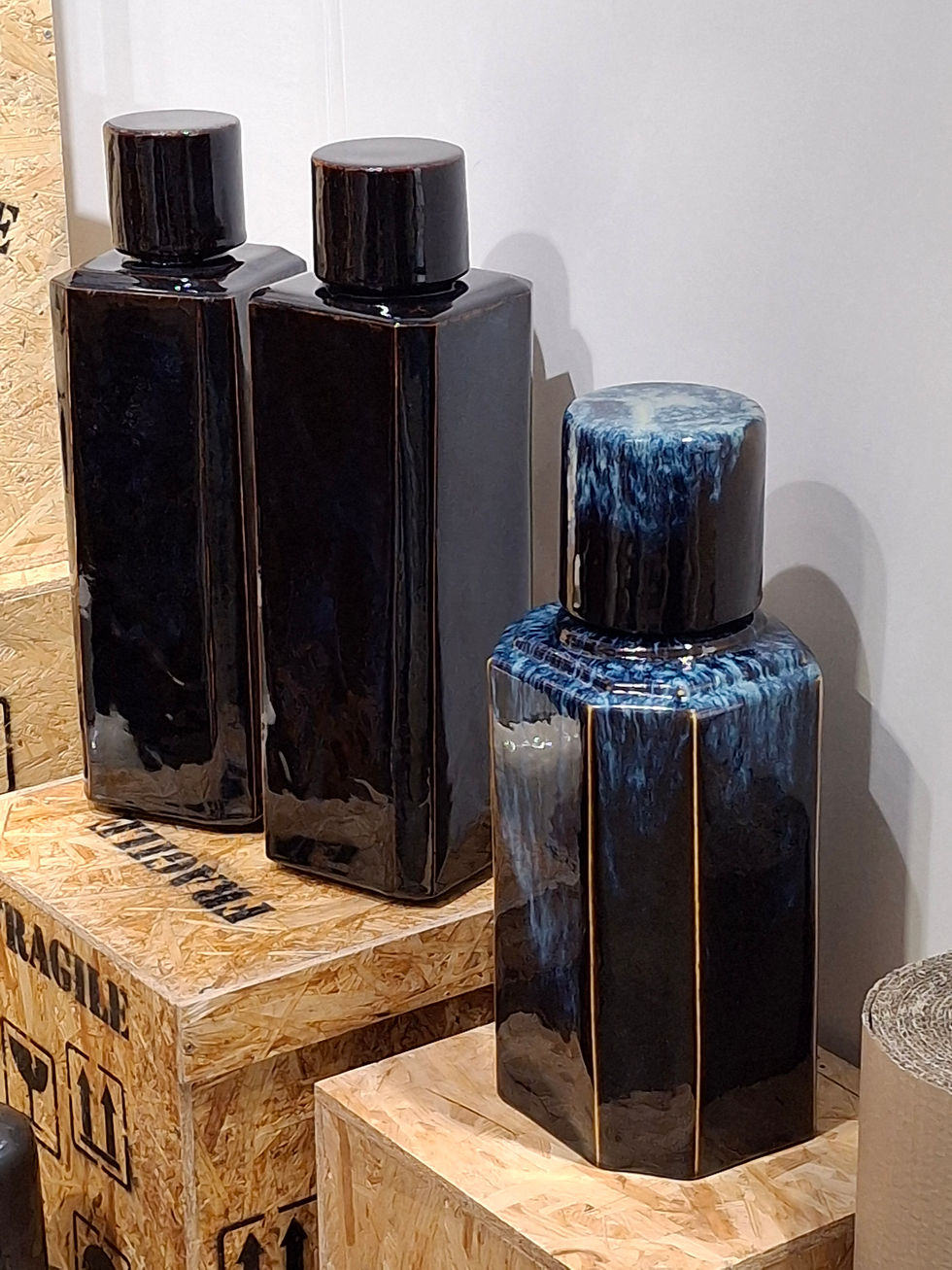
Timothy Fluck
I thought his work look wacky and reminded me of liquorish allsorts. It was reminiscent of sixties fashion culture to me. I was drawn to the work, but thought it wasn't my thing. Although knowing his work has its origins in architecture and the promise of Utopia, this changed my conception of it somewhat.

Shirley Vauvelle
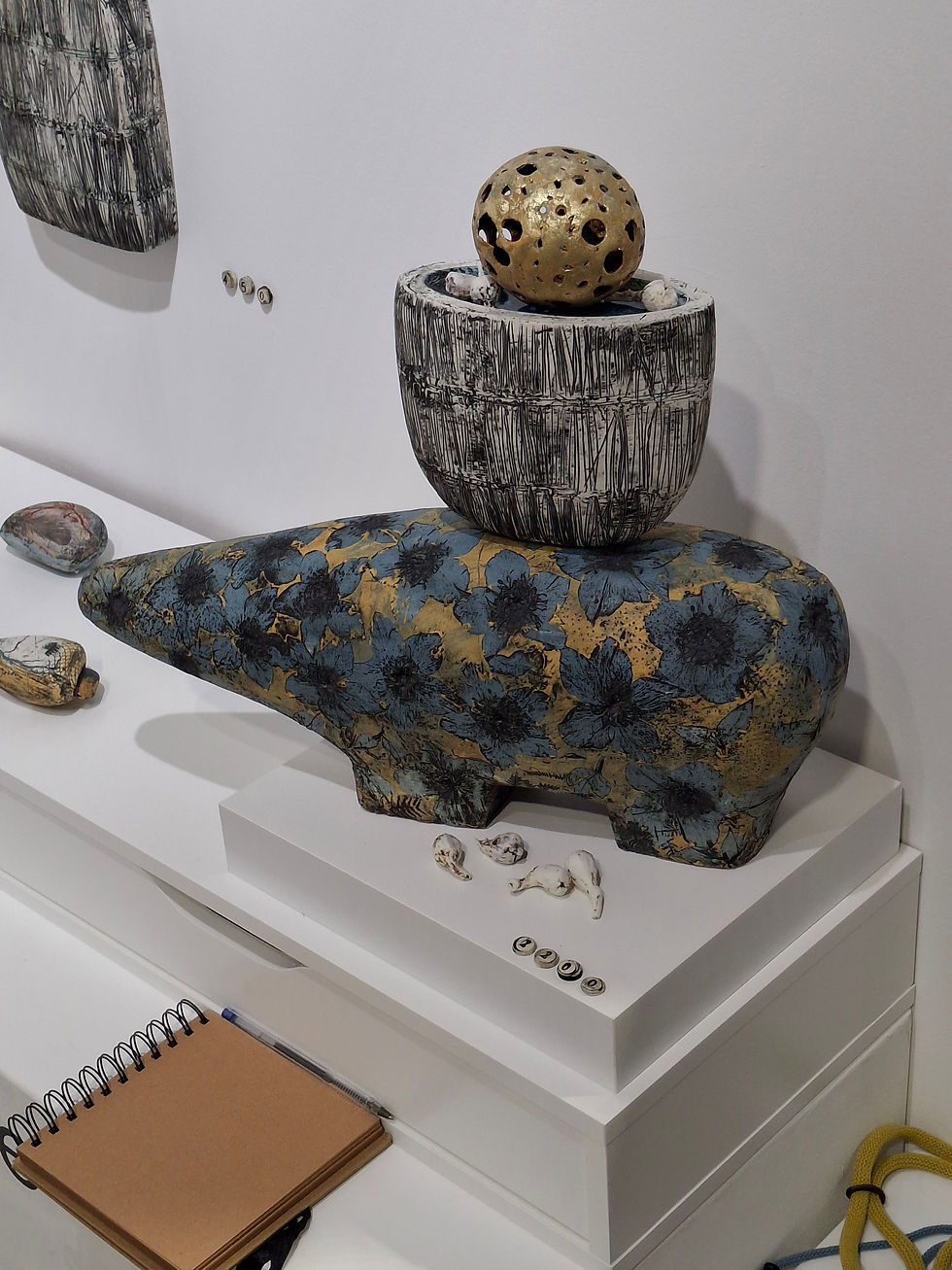

Shirley Vauvelle
I thought her ceramics were very nice, probably my favorite of the show. I asked what she gets her inspiration for her animals from and she said inuit carvings. Her work comes out of her head, from her imagination and they are not supposed to be particular animals. She said they were a community or herd and told a story. There were some that were good news for hope, and some animals were carriers or bearers. She had three birds on top of one. I asked if they were oxpeckers, as I have a piece with three ox-peckers on a rhino. She said they weren't meant to be ox-peckers but from her imagination, and working with nature.
Her work reminded me of Lorna Graves, though she wasn't familiar with Lorna Graves. My Mum and I went to a lecture by Lorna, 40 years ago at the Brewery Arts Centre.
I liked the way her work was a bit surreal and told a story, yet connected to nature. I have recently become more interested in surrealist art, I think from seeing Aliyah's work, from exhibiting at Astley Hall last year, where there was a separate Leonora Carrington exhibit, and seeing the exhibition ' 40 years of Surrealist Landscapes' at the Hepworth this year.
With all the doom and gloom going on in the world we need a bit of escapist imagination.
She has Open Studios on 2nd November 2025 in Scarborough. I would like to try and go.
Lorraine Rutt

Lorraine was a draughtswoman originally and worked at one of the London Universitys. She pointed out that maps of the globe don't actually match up to how the earth is in reality - she had cut up a globe and laid it flat to demonstrate this. The maps she draws very accurately on porcelain using specially made precision instruments. The jet streams and ocean currents are depicted with words. One such stream said 'The body of the world lacks sinews, this is because the sinews are exposed.' By this she could mean man's exploitation of the natural world and its resources, both animal and mineral.
Her accuracy and cartology was impressive, and she said she likes data, whereas I tend to shy away from it.
The current exhibition at Castlefield Gallery, Manchester called Energy House, by Emily Speed and Mishka Hanna uses live data. Live lightening data from around the world is collected as it happens and turned into precusssion sounds. I look forward to hopefully visiting this exhibition. It runs from 4th May to 20th July.
Barry Stedman
This was brightly coloured free painting, with slip I think. He is inspired by the countryside around his home by the River Flit in Bedfordshire. I liked the forms, though this is now too abstract for me - I used to be drawn to this type of ceramics. I now tend to find abstract a bit meaningless ( my own opinion), though pleasing to look at.
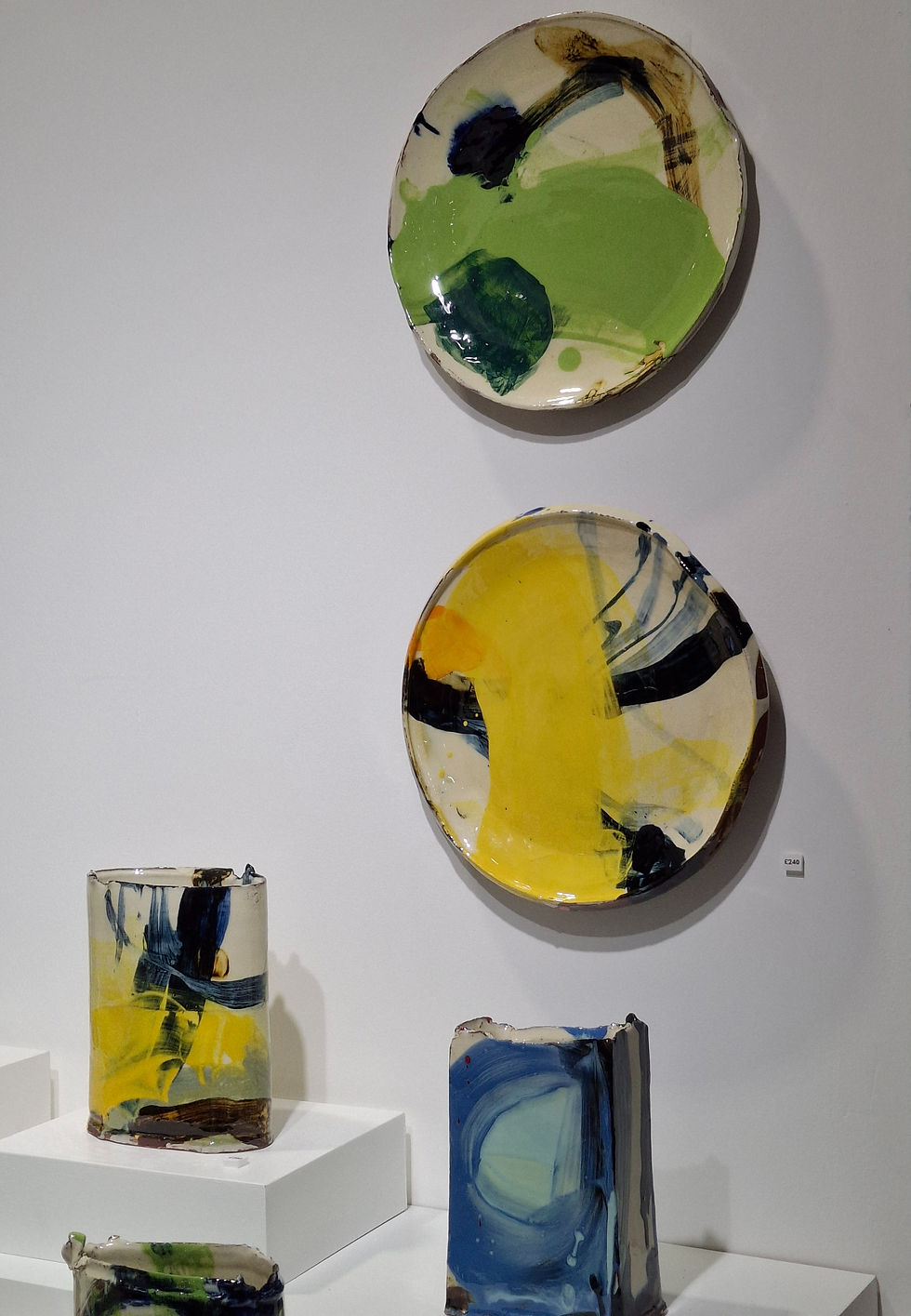
Emily Gibbard

Emily is a young graduate. I thought her work was interesting and thought provoking.
She explores sculpture representing body perception, identity and sexuality. Her vessels are thrown, with throwing rings left to add effect. I liked the holes, which to me represented eyes.
I thought her work would be of interest to Ruth, Kim and Lucy. I took some leaflets by her.
Carol Sinclair
These were grey and white pots with blossoms, I liked them for their simplicity and clean lines.

Jemma Gowland
I saw and liked Jemma's confrontational work at the BCB.

I liked the idea of some of the dolls using lipstick as a weapon, not on this photo. (Throw back to Debbie's work?)
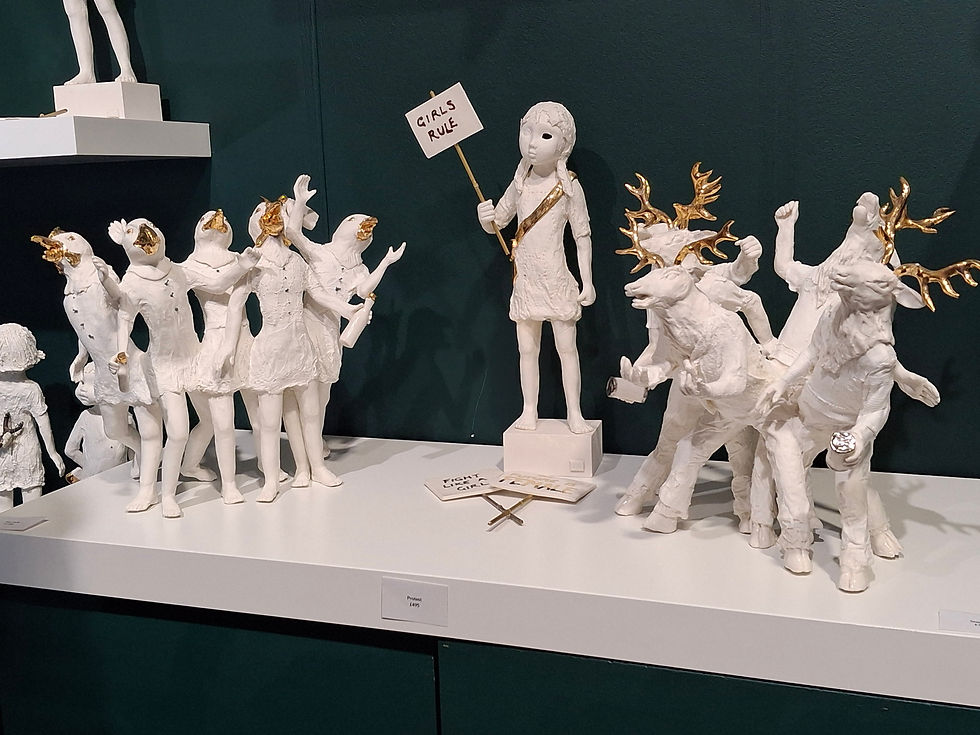
I thought "Hen Party" was very clever - a clever play on words too. In this piece I think she's saying women are as badly behaved as men, different from the meaning I get of some of her other pieces which are about empowerment for women.
I do find her dolls faces a bit macabre though! They remind me of voodo dolls.
Rachel Peters

This was a large form of a woman's body. It was tactile with the grog showing through. I liked the smooth curves and the texture.
Tim Martin
The shapes and colours and surface were aesthetically pleasing and tactile. The words which sum up why I was attracted to the work are:
Trees, different colours, rounded forms, simplicity.
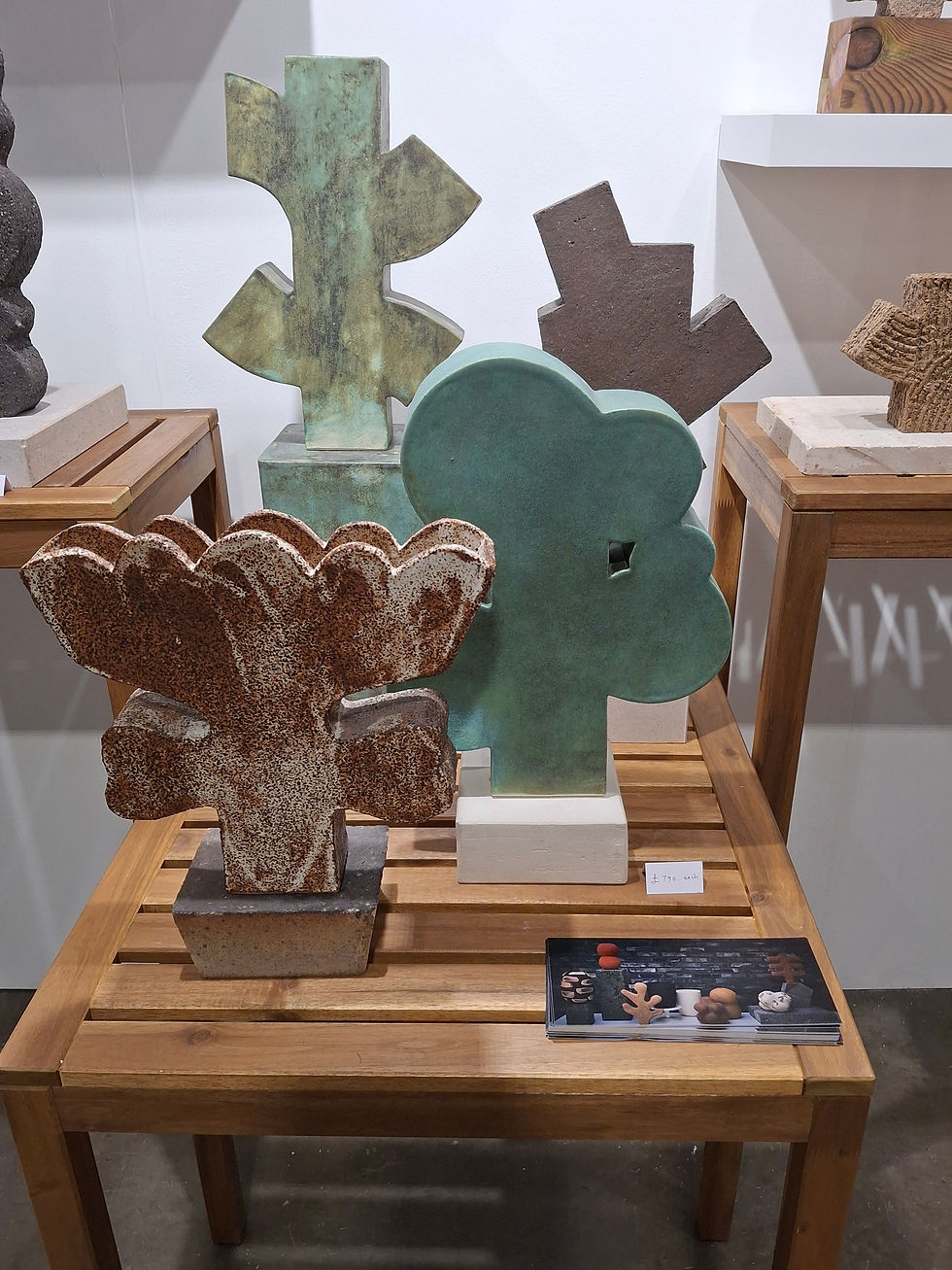
Ian Thompson
His work is (slightly) confrontational and very accomplished. He has a MA from the Royal College and his first degree is in Fine Art. He combines the two disciplines to produce exquisite pots. He is influenced by Blue and White ware and the Far East. He deals with things like confidence and insecurity in your inner mind. I also class myself as using clay as a canvass. When I said that my project was 'Man's negative impact with Animals', he said ' we were both singing from the same hymn sheet', which I took as a big complement!
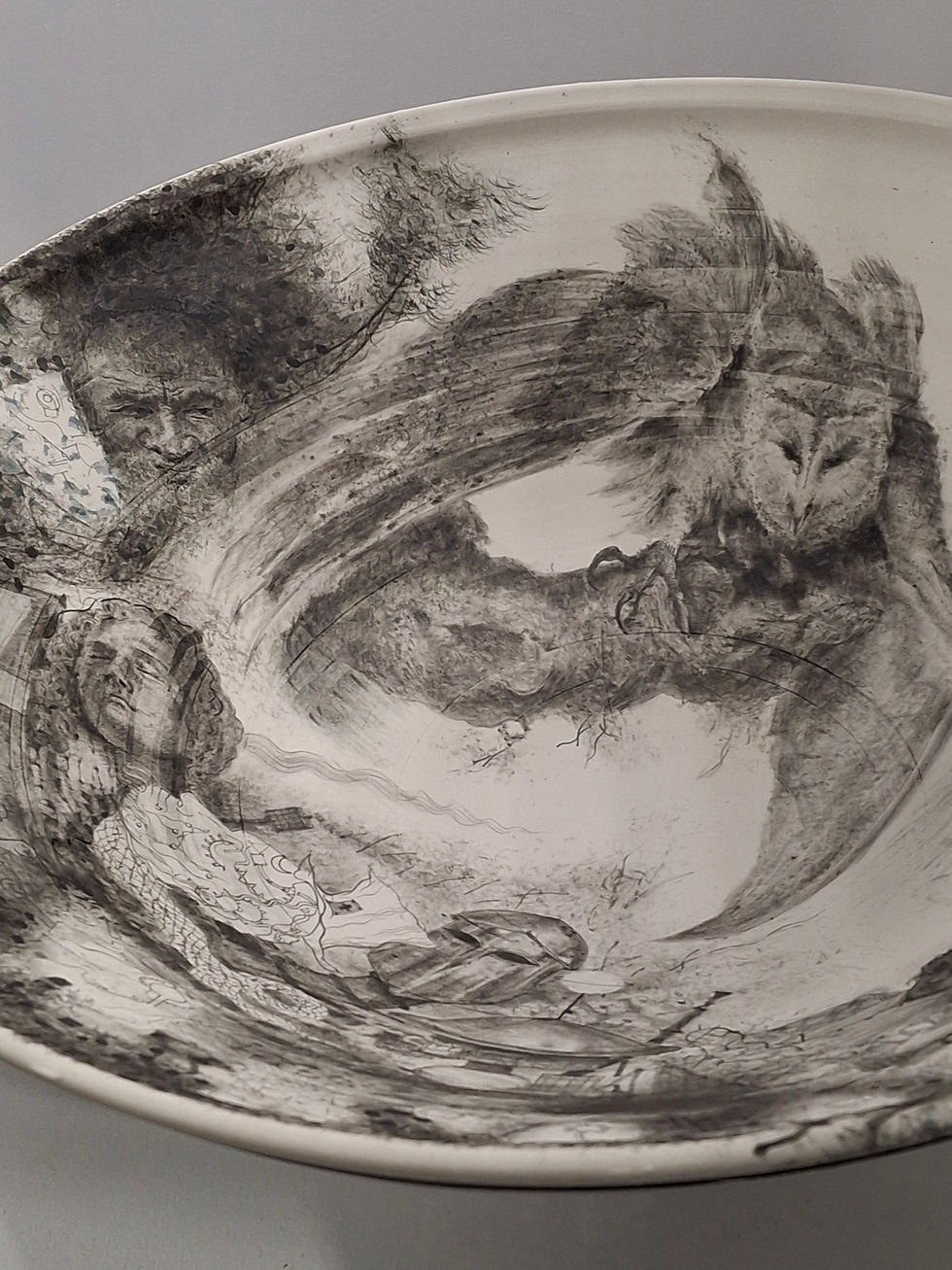
Yuta Segawar
He had made a whole throng/wave of miniature vessels. They were all different colours. He makes them on a full size wheel, so a lot of skill involved. Personally I am not particularly interested in miniatures, except for maquettes. But I appreciate the skill that has gone into making them. I like oversized ceramics.

Helen Rondell

Helen works with Naked Raku and her work is very accomplished. I have tried this once or twice on experimental pieces a long time ago. The turquoise colour is made by applying turquoise slip underneath....I suppose you could adapt this to any colour? She uses 'resist slips' which I had never heard of, but I suppose they peel off easier after the firing and smoking part.
She says the shapes and negative spaces and designs on her pots 'create calming presence'.
She is influenced by her travels in southwestern United States. She visited some Pueblo Galleries in New Mexico ( where my Mum lived for a time in the fifties). She is particularly influenced by the shapes and designs of Martina Martinez, particularly Native American wedding vases.
Hanna Salomonsson

Hanna Salomonsson is a London based Swedish ceramic artist. She gets inspiration from Scandinavian folklore, of which there is a lot! She is also interested in how identity is tied in with your childhood landscapes. She uses coiling, slabbing and carving to make her pieces.
Her use of clay reminds me strongly of butterflies ( which I am fond of). She uses colours in the clay, and then cuts the clay to produce a butterfly wing effect.
Butterflies were a theme of a University of Lancashire degree artist Cassia Williamson....these are her beautiful fabric creations...

Paul James
Paul throws different coloured vessels and then cuts the top off one colour and joins it to the bottom of another colour, often using coloured slip to join....Ingenious!

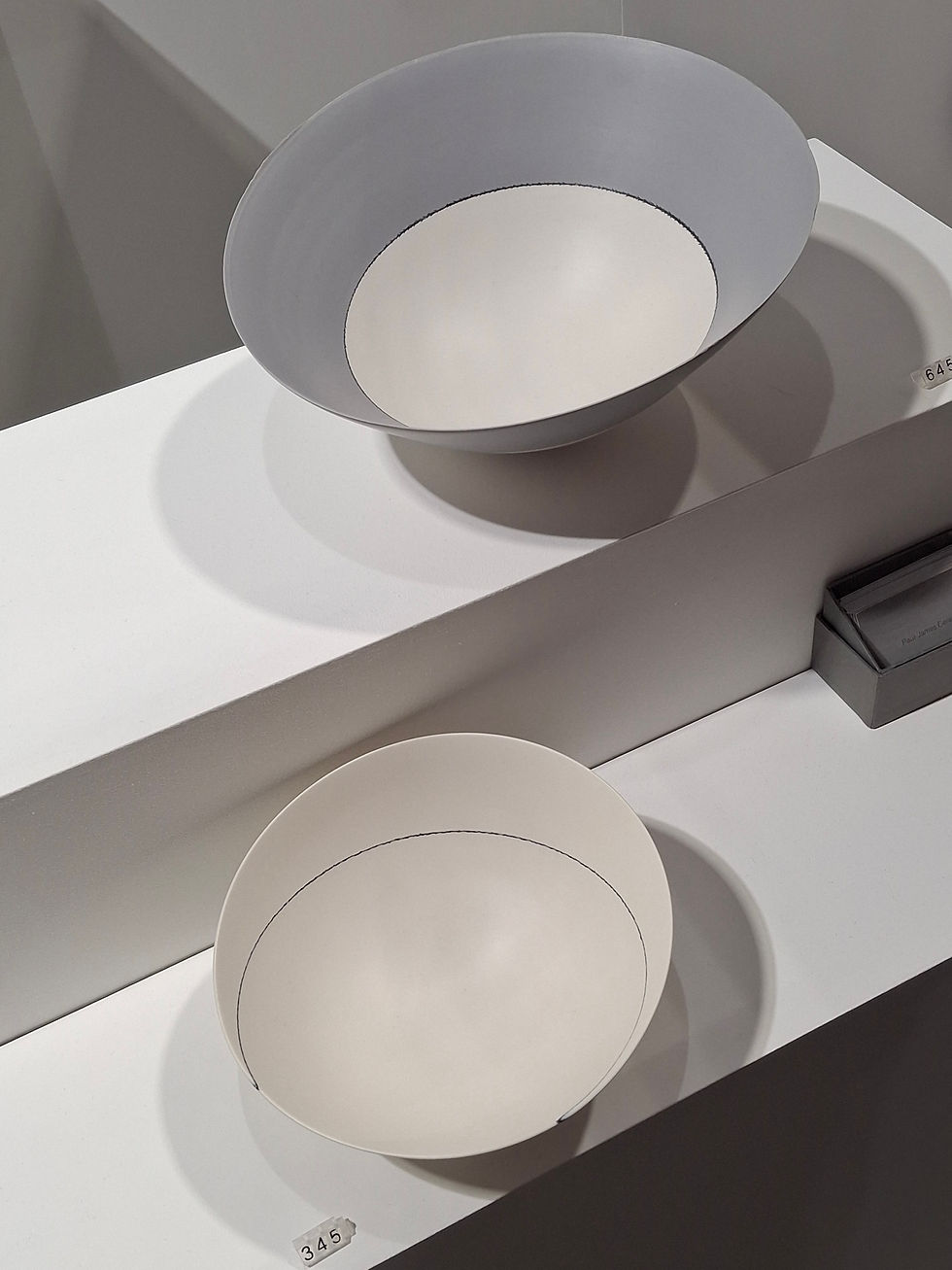
Julie Ayton
Julie uses sgraffito to cut through glazes. She raw glazes then applies sgraffito, then fires to stoneware bisque. She will then put another glaze on, uses sgraffito and fires to glaze temperature. Or she just fires to glaze temperature if only one glaze used.
She isn't worried that the first glaze is not immediately in a glaze firing, she says it just matures when fired in the second firing. I think this could possible be specific to special glazes ie will not work with all glazes? An interesting technique, related by sgraffito to the work I do, but not the same as the marks are made through glaze not slip.
She masks with wax with some of her cups.

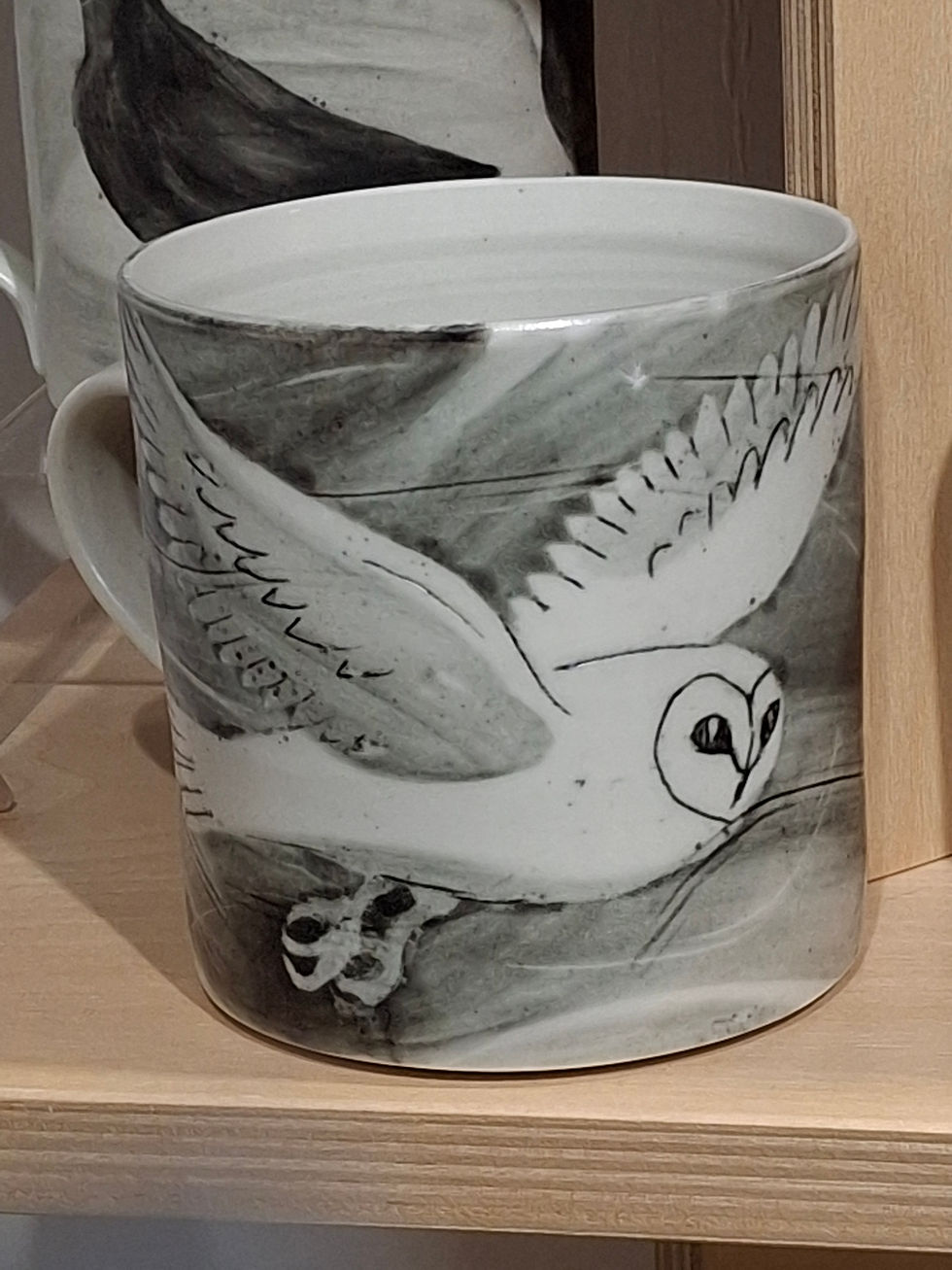
Micaela Schoop
I have followed Micaela's work for quite a while. It is developing all the time, different aspects appearing in her decoration and use of clay. The colours are lovely. I am in awe of someone who works so precisely. She said she can cover over mistakes, which is just as well - very complicated, a lot going on.

I read the QR codes on this piece, they are the dictionary definition (Wikipedia) of:
Sense of Entitlement
Slippery Slope and
Envy and Greed.
I can relate to this and see they are all linked! Maybe they accompany the topics in the morse code, which I haven't read yet.

I especially like the black clay with shellac, scraped back and then polished with beeswax.

The little bowl above with the unglazed centre was my favourite. You could tell it had been carefully decorated but very refreshing....less precise, like snowscape.
This is another of Micaela's small bowls, as ever exquisitely decorated and beautiful colours.

Last, but certainly not least..
Oriel Zinaburg
He was a very nice man, and Italian. I thought his pieces, which were very large, resembled coral, or they could have been the jets of air that rise from the deep ocean bed, he said.
I hoped that our work was elementally singing off the same hymn sheet too!

There were many other exhibitors whose work I thought intriguing, or cleverly constructed or unusually decorated, to name but a few assets....for example:
Raquel Eidem
Alex Garnett
Tanya Gomez
Bronwen Grieves
James Hake
Ashraf Hanna
Bjork Haraldsdottir
Ruth King
Katharina Klug
Simone Krug-Springsguth
Stephen Murfitt
Richard Millar.
An enjoyable visit!







Comments